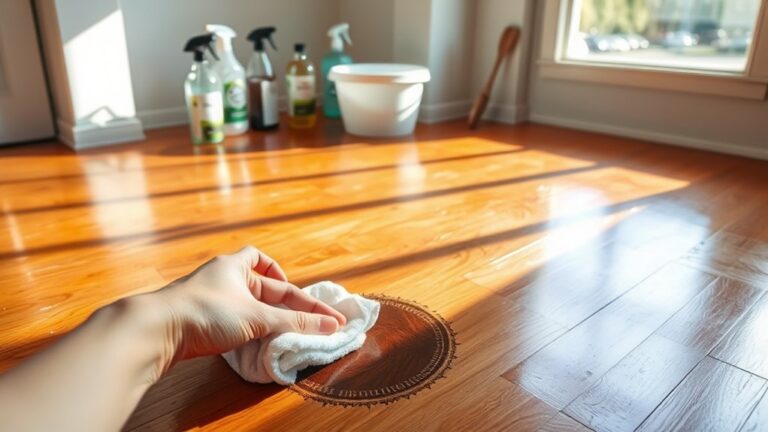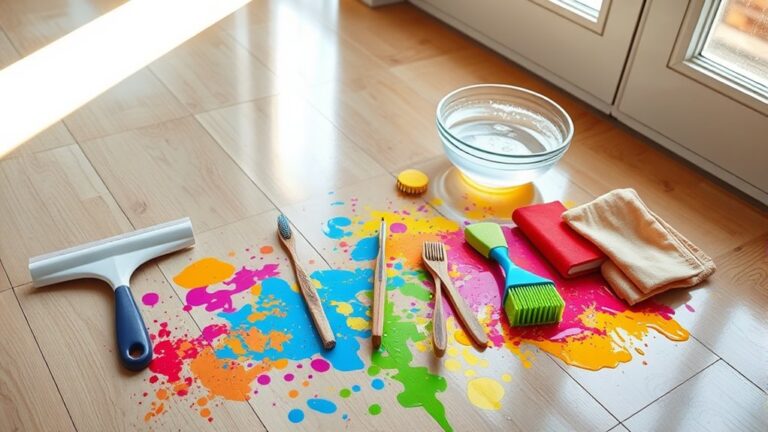To get nail polish off wood floors, first test an acetone-free remover on a hidden spot to avoid damage. Dab the stain gently with a soft cloth to lift polish without spreading it. If that’s not enough, try gentle household options like rubbing alcohol or a baking soda paste, applying with care. Always wipe the area dry and avoid harsh scrubbing to protect the finish. For more tips on safely cleaning and protecting your wood floors, keep exploring the best methods.
Assessing the Type of Wood and Finish

Before you start removing nail polish from your wood floors, it’s important to identify the type of wood and finish you’re dealing with. Different wood types like oak, maple, or pine absorb stains and cleaning agents differently. For example, softer woods may be more prone to damage. Next, pinpoint the finish type—whether it’s polyurethane, varnish, wax, or shellac. Each finish reacts uniquely to solvents and scrubbing. Polyurethane, a common finish, is more resistant to chemicals, while wax finishes can be easily damaged by harsh cleaners. Knowing your wood and finish types helps you choose the safest, most effective removal method without compromising your floor’s integrity. This understanding gives you the freedom to tackle nail polish stains confidently and protect your wood floors long-term.
Preparing Your Cleaning Supplies
Knowing your wood type and finish helps you select the right cleaning supplies that won’t harm your floors. Before you start, gather effective cleaning tools and materials that focus on stain prevention and gentle removal.
Understanding your wood type ensures you pick safe cleaning supplies that protect your floors during stain removal.
- Choose soft cloths or microfiber towels to avoid scratches.
- Select a mild, wood-safe cleaner or gentle soap diluted with water.
- Have cotton swabs or cotton balls ready for precise application.
- Keep paper towels or an absorbent cloth nearby to quickly blot spills.
Avoid harsh chemicals or abrasive tools that can damage the finish or wood itself. Preparing these supplies in advance guarantees you act quickly and carefully, preserving your floor’s natural beauty while tackling that unwanted nail polish effectively and safely.
Using Nail Polish Remover Safely on Wood

Before using nail polish remover, pick one that’s acetone-free to avoid damaging your wood floor’s finish. Protect surrounding areas by testing a small, hidden spot first and using a soft cloth to apply the remover gently. With careful application, you can remove the polish without harming the wood underneath.
Choosing the Right Remover
Although nail polish remover can effectively lift stains, not all types are safe for wood floors. Choosing the right remover means balancing effectiveness with wood protection. Here’s what you should consider:
- Acetone-based removers work fast but can damage finishes and dry out wood.
- Non-acetone removers are gentler and less likely to harm your pavimento.
- Eco friendly options often use natural solvents and avoid harsh chemicals, offering a safer choice for both you and your wood.
- Always test a small, hidden spot first to verify no discoloration or damage occurs.
Protecting Wood Surfaces
To protect your wood floors while removing nail polish, you’ll want to take a few careful steps. Using nail polish remover safely on wood involves testing first, applying sparingly, and acting quickly to avoid damage. Good wood floor care means preventing stains and preserving finish integrity.
| Fare un passo | Why It Matters | Wood Floor Care Tip |
|---|---|---|
| Test in a hidden spot | Avoid discoloration | Use a cotton swab |
| Use minimal remover | Prevent finish damage | Dab gently, don’t soak |
| Blot spills quickly | Stop stains early | Use a clean cloth immediately |
| Condition wood after | Restore moisture | Apply wood-safe oil or wax |
Following these keeps your floors safe and helps with effective stain prevention.
Application Tips and Tricks
Once you’ve taken steps to protect your wood floors, applying nail polish remover correctly becomes key to avoiding damage. You want to remove that nail polish without compromising your wood care routine. Here’s how you can do it safely:
- Test first – apply a small amount of remover on an inconspicuous spot to check for any adverse reactions.
- Use acetone-free remover to minimize harsh chemical exposure.
- Dab gently with a soft cloth; avoid rubbing hard to prevent finish damage.
- Immediately clean the area with a damp cloth and dry thoroughly to remove residue.
Following these tips lets you confidently remove nail polish while preserving your wood floors’ beauty and integrity.
Alternative Household Remedies to Try

When you don’t have commercial removers on hand, several household items can effectively lift nail polish from wood floors. These natural alternatives use everyday ingredients you likely have, offering a gentle yet practical solution. Here’s a quick guide to get you started:
| Household Item | How It Works |
|---|---|
| Rubbing Alcohol | Breaks down polish without harsh chemicals |
| Vinegar & Lemon Juice | Natural acids help dissolve stains |
| Pasta di bicarbonato di sodio | Mild abrasive that lifts polish gently |
Apply a small amount on a cloth, dab the stain, and let the remedy sit briefly before wiping clean. These options give you freedom from harsh chemicals, keeping your wood safe while effectively tackling the mess.
Gentle Scrubbing Techniques for Stubborn Stains
Two key tools you’ll need for gentle scrubbing are a soft-bristle brush and a microfiber cloth. These help apply gentle abrasives without damaging your wood floor’s finish. For effective stain removal, follow these steps:
- Dampen the microfiber cloth with warm water and a mild detergent.
- Gently rub the nail polish spot using the soft-bristle brush in circular motions.
- Avoid harsh scrubbing to protect the wood surface and prevent scratches.
- Wipe the area with a clean, dry microfiber cloth to remove residue and moisture.
How to Treat and Protect the Wood After Cleaning
Once you’ve removed the nail polish, it’s important to condition the wood to restore moisture and prevent drying. Applying a protective finish will help shield the floor from future stains and damage. Let’s explore simple wood conditioning tips and effective finishing methods to keep your floors looking great.
Wood Conditioning Tips
After removing nail polish from your wood floors, you’ll want to focus on conditioning the surface to restore moisture and protect it from future damage. Proper wood care is key to extending the life of your floors and maintaining their natural beauty. Here’s how to do it right:
- Clean gently: Use a damp, soft cloth to remove any residue without stripping natural oils.
- Apply wood conditioner: Choose a product suitable for your floor type to replenish moisture and prevent drying.
- Buff the surface: After conditioning, gently buff with a soft cloth to enhance shine and smoothness.
- Regular floor maintenance: Schedule periodic conditioning sessions to keep your wood floors healthy and resilient.
Stick to these steps, and your floors will stay protected while preserving that freedom of natural wood feel.
Protective Finishing Methods
Although cleaning and conditioning your wood floors are essential, applying a protective finish is what truly safeguards the surface from future wear and stains. After removing nail polish, you’ll want to choose the right finishing products that suit your floor’s type and usage. Protective coatings like polyurethane or water-based sealers create a durable barrier, preventing spills and scuffs from penetrating the wood. Make sure to apply these coatings evenly and allow proper drying time to maximize their effectiveness. Regular maintenance, such as light buffing and reapplying finishing products when needed, will keep your floors looking fresh and resilient. Taking these steps lets you enjoy your wood floors without worrying about damage, giving you the freedom to live boldly while protecting your investment.
Preventing Future Nail Polish Stains on Wood Floors
To keep your wood floors looking their best, it’s important to take proactive steps to prevent nail polish stains from happening in the first place. Implementing preventive measures now will save you time and effort in future maintenance. Here’s how you can protect your floors effectively:
- Always apply a high-quality protective sealant or finish to create a barrier against spills.
- Use area rugs or mats in spaces where nail polish is frequently used.
- Store nail polish and remover in secure, designated areas away from floor-level access.
- Clean up any drips or spills immediately with a soft cloth and mild cleaner.




